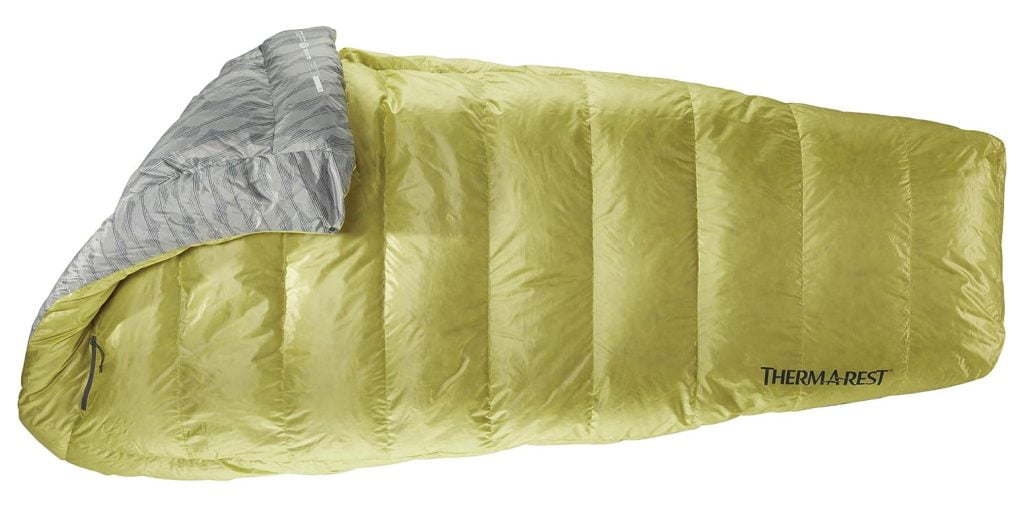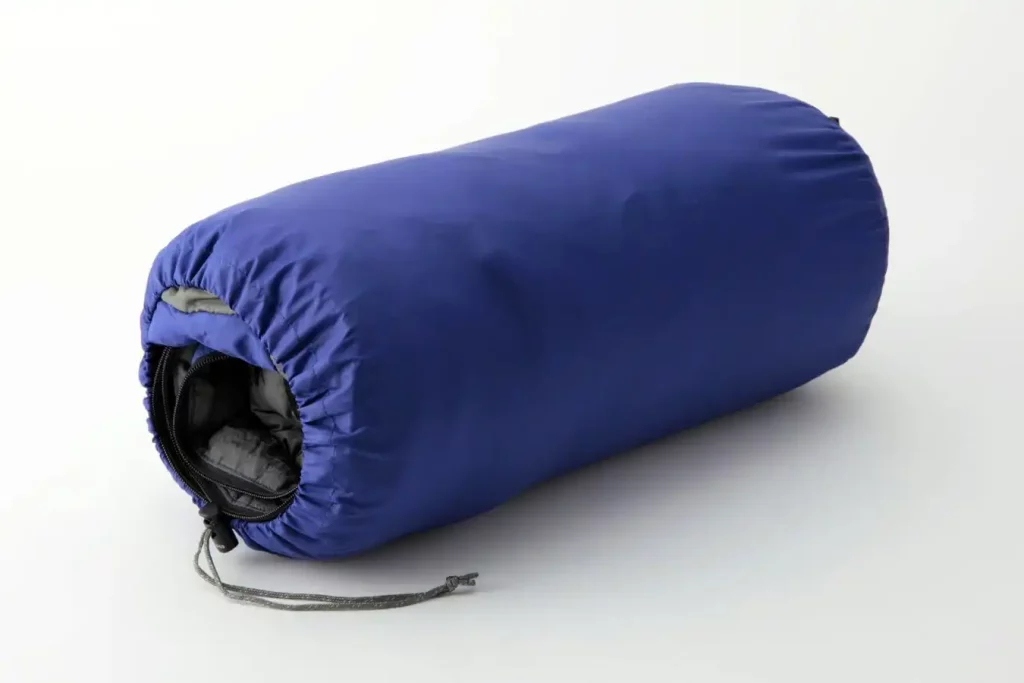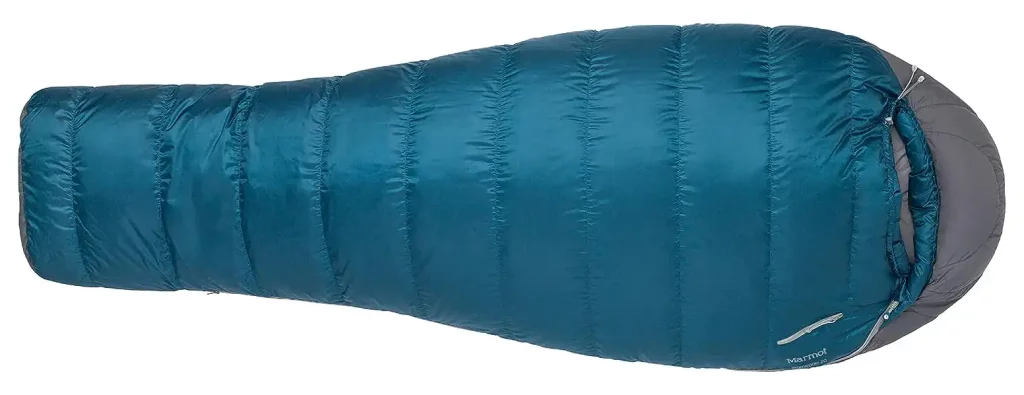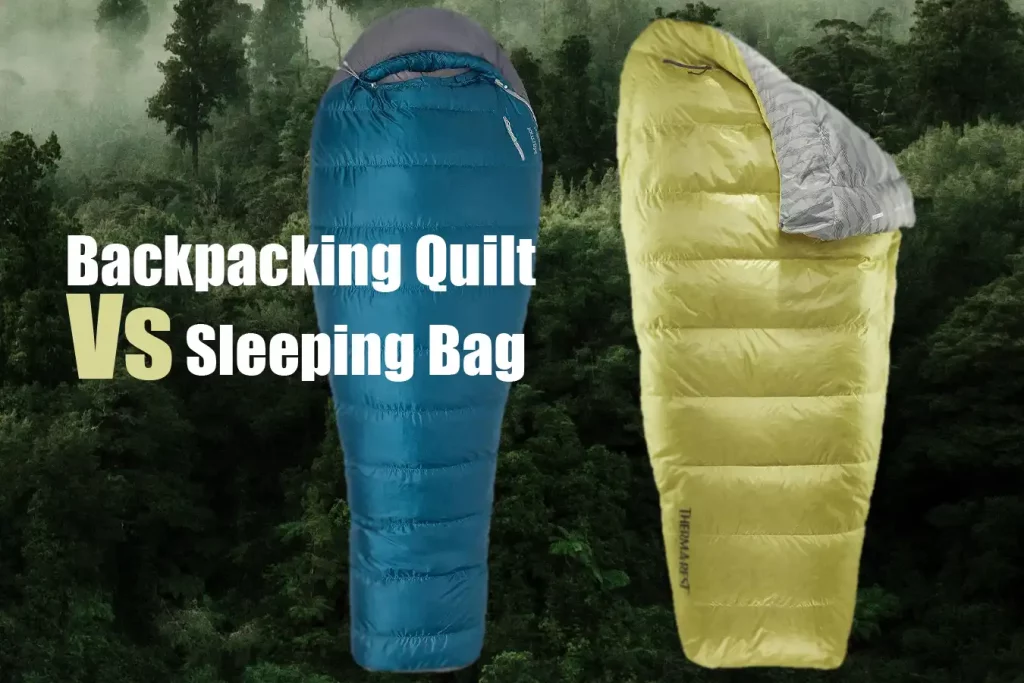Backpacking quilt vs sleeping bag: Ah, the eternal debate that’s puzzled adventurers for years!
You’re here because, like me, you value a good night’s sleep under the stars—but how to achieve it, that’s the question.
Do you go for the tried-and-true sleeping bag or opt for the trendy, minimalist appeal of a quilt?
In this guide, we’ll unpack (see what I did there?) the nitty-gritty details of each option.
I promise you, by the end, you’ll be a step closer to your dream camping setup—pun intended.
Get ready to make your outdoor snoozes both cozy and efficient!
Understanding the Basics
Ever found yourself tangled in the backpacking quilt vs sleeping bag decision? Yeah, it’s like picking between Netflix shows—tough but consequential. Before we dive deep, let’s get a brief lay of the land.
What is a backpacking quilt?
A backpacking quilt is a lightweight, versatile alternative to a sleeping bag, providing warmth without the bulk and offering easier temperature regulation.

Design and functionality
A backpacking quilt is essentially an open sleeping system, meaning it doesn’t fully enclose you. Picture this: it’s a crisp morning, and you’re wrapped in a snug quilt, sipping on your camp coffee, with the ability to stick out your feet or wrap it tight. It gives you flexibility depending on the temperature. Plus, if you’re someone who feels trapped in confined spaces, the quilt’s your hero!
Common materials and weights
Quilts are all about staying warm without weighing you down. The champions in this field are typically made from lightweight materials like ripstop nylon and are filled with either down or synthetic insulation. For ultralight enthusiasts, a down-filled quilt that weighs less than a pound can be a game-changer. But remember, the right balance between weight and warmth is crucial!
What is a Sleeping Bag?
A sleeping bag is a cozy, insulated cocoon designed to keep you warm and protected from the elements while you sleep outdoors. Think of it as your outdoor cocoon. 🐛

Types: Mummy, rectangular, and semi-rectangular
- Mummy: Tight-fitting, perfect for cold conditions. You know, the kind where you want to look like an adventure burrito.
- Rectangular: Roomier and comfier, it gives you space to sprawl out. Ideal for those camping nights when you’re not too concerned about the chilly breeze.
- Semi-rectangular: The middle child of sleeping bags. Balancing space and warmth, it’s for those who want the best of both worlds.

Insulation types: Down vs. synthetic
- Down: Light, warm, and can be compressed to a tiny size. Perfect for those long treks. But it has a kryptonite: moisture! Wet down can lose its insulating power.
- Synthetic: Might be a tad heavier, but it holds its own in damp conditions. If you’re hiking in wet climates or places with unpredictable weather, this might be your jam.
There you have it, folks! Whether you’re cozied up in a quilt or snuggled in a sleeping bag, remember – the best choice is the one that keeps you warm and lets your adventure spirit soar.
Learn more: How Much Does a Sleeping Bag Weigh
Key Differences: Backpacking Quilt vs Sleeping Bag
Alright, you’ve got the basics down—awesome! Now let’s get into the nitty-gritty: What sets these two apart?
Weight and Compressibility: Backpacking Quilt Vs Sleeping Bag
The minimalist appeal of quilts
Let’s talk ultralight, baby! Quilts are generally lighter and more compressible than sleeping bags. How come? Well, they’re designed with fewer materials. No zippers, less insulation, and voilà—you’ve got a minimalist’s dream. Imagine hiking up a steep hill; every ounce counts, right? Well, a quilt might just be your new best friend for shedding those extra pounds off your back.
Sleeping bags’ varying weights
On the flip side, sleeping bags can vary a lot in weight. If you opt for a synthetic, expect a heavier load. However, some down bags are shockingly light, though not quite as light as quilts. Plus, sleeping bags usually come with extra features like hoods and zippers that add a bit to the weight. So, if you’re the kind who likes a feature-rich sleep setup, a lightweight sleeping bag could still be up your alley.
Temperature Rating: Backpacking Quilt Vs Sleeping Bag
Quilt versatility and layering
Quilts are pretty darn versatile, especially when it comes to temperature adjustments. You can easily layer clothing or another blanket under your quilt to crank up the heat. Plus, they offer an open design, allowing you to vent excess heat by sticking out a leg. Versatility, thy name is Quilt!
Sleeping bag warmth and drafts
Sleeping bags, especially mummy types, are designed to be snug, which minimizes drafts. So when the temps drop, you’re still in your cozy little cocoon. The downside? It’s not as versatile when the weather heats up. You can unzip it, but at some point, it can still feel like a sweatbox.
Coverage and Comfort: Backpacking Quilt Vs Sleeping Bag
The “open back” design of quilts
Now, the ‘open back’ design of quilts is a game-changer. It essentially lacks the material that would be under you in a sleeping bag, offering a direct contact surface between your sleeping pad and your back. This makes for more efficient heat transfer. But keep in mind, if you’re the type who moves a lot in sleep, this design might leave you exposed to the cold ground.
The cocoon effect of sleeping bags
Sleeping bags, on the other hand, encapsulate you in a warm hug from head to toe. Some even come with hoods for added warmth. You’re completely covered, and drafts are pretty much a non-issue. But you pay for this luxury in the form of extra weight and decreased compressibility.
You know, the eternal debate of backpacking quilt vs sleeping bag is almost like choosing between coffee and tea for morning hikes—it’s all about personal preference. Each has its pros and cons, and what’s best for you boils down to your personal needs, the conditions you’ll be facing, and how much you’re willing to carry. Do you want the versatility and lightness of a quilt, or the all-encompassing warmth of a sleeping bag? The choice, my adventurous friend, is all yours. 🌲🌌
A pursuit comparison for serious outdoor enthusiasts: Backpacking Vs Hiking
Usability and Versatility: Backpacking Quilt Vs Sleeping Bag
Beyond just weight and warmth, how do quilts and sleeping bags fare when put to the test in various situations? Let’s dive in.
Situational Advantages of Backpacking Quilts
Quilts are like the Swiss Army knife of backcountry bedding. Perfect for warm summer nights, they’re also a lifesaver when you want to lighten your load. Plus, they double up nicely as a blanket around the campfire or in the hammock. If you’re the type who changes elevation and temperature frequently, a quilt can quickly adapt without locking you into a sweaty, overheated mess. Yep, it’s that versatile!
Scenarios Where Sleeping Bags Shine
Alright, let’s give sleeping bags their moment. When you’re facing the chilly unknown, nothing quite beats being zipped up in a sleeping bag. If you’re in snowy or very cold conditions, a mummy bag with a hood can be the difference between a miserable night and a cozy slumber. They’re also ideal for folks who aren’t too keen on the ‘fuss and adjustments’ required by quilts. Unzip, crawl in, and boom—you’re good to go!
Transitioning Between Seasons
What happens when you’re crossing from spring to summer, or summer to fall? In these transitional seasons, quilts and sleeping bags both have their merits. Quilts are perfect for layering, so you can simply add or remove layers as the temperature fluctuates. Sleeping bags, particularly those with double zippers, allow you to vent heat without completely exposing yourself to the elements.
Combining Both for Optimal Warmth
Now, here’s a hack for the ultimate warmth-seeker: Why not use both? Yep, you heard me. When temperatures plummet, a quilt can be layered on top of a sleeping bag, offering an extra layer of insulation and reducing the chances of cold air sneaking in. Just make sure the combined weight makes sense for your trek; otherwise, you’ll be wrestling with your conscience (and your backpack) the whole way. 🌙⛺
Financial Implications: Backpacking Quilt Vs Sleeping Bag
Let’s talk money, honey! The eternal tug-of-war between quality and budget applies here too. So how do quilts and sleeping bags measure up financially?
Cost Differences: Initial Investment and Long-Term Value
Quilts are often seen as the budget-friendly option, but don’t be fooled! The high-quality down quilts, with their lightweight and durable design, can cost as much as a premium sleeping bag. However, if you’re an occasional backpacker sticking to mild climates, a basic quilt might be all you need, and those come cheaper.
Sleeping bags? Ah, that’s where the range gets wild! From budget-friendly to a small fortune, the prices cover a broad spectrum. A good sleeping bag is like a fine wine; you can’t really put a price on comfort and security. But be warned: The higher the down quality and lower the temperature rating, the higher the cost will shoot up.
Durability and Warranty Considerations
Let’s be honest: No one wants to buy a sleeping solution every other season. Both quilts and sleeping bags can last a good while if taken care of. However, sleeping bags, especially those with synthetic fills, may lose their loft quicker, causing them to become less warm over time.
Warranties? Most reputable companies offer them. So whether you go for a quilt or a sleeping bag, ensure you check out the warranty terms. It’s always good to have a safety net, right?
Sustainability and Environmental Impact: Backpacking Quilt Vs Sleeping Bag
Bet you didn’t think your bedtime choices could have an eco-impact, huh? Well, they do, and it’s worth considering.
Ethical Sourcing of Down
If you lean towards down-filled products, you’ve got some homework to do. Always check if the down is ethically sourced. No one wants their cozy slumber to come at the cost of animal cruelty. Look for certifications like Responsible Down Standard (RDS) to make sure you’re on the right path.
Synthetic Materials and Their Environmental Footprint
Synthetic fills are often petroleum-based, so not exactly a win for Mother Earth. However, some brands are taking strides towards recycled synthetics, which is a step in the right direction. If you’re eco-conscious, this might tip the scales for you.
Sustainable Practices Among Top Manufacturers
Some companies are going the extra mile with sustainable practices, from renewable energy-powered factories to recycled packaging. Do a little digging into a brand’s sustainability initiatives before making your purchase. After all, a little goes a long way, especially when it’s for the planet.
So, whether it’s the cost, the ethical considerations, or the long-term durability that’s swaying you, remember: It’s not just about a good night’s sleep; it’s about making choices that let you sleep with a good conscience. 🌿💤
Customization and Personal Preferences: Backpacking Quilt Vs Sleeping Bag
Let’s get personal! Customization can make or break your outdoor sleeping experience. So how do quilts and sleeping bags stack up?
Custom Quilt Options and Benefits
Ever wanted a bed in the wilderness that feels like it’s made just for you? Enter custom quilts. Many manufacturers offer bespoke options like length, width, and even color. You can tailor the insulation level and choose specialized materials based on where and when you’ll be backpacking.
Feeling chilly feet? Get a foot box added. Love the night sky but hate bugs? Opt for a specialized upper layer that repels insects. The possibilities are endless, really!
Sleeping Bag Size and Fit Considerations
Sleeping bags are generally more “what you see is what you get,” but that doesn’t mean you’re stuck with a one-size-fits-all scenario. Far from it! They come in various lengths and even shapes (remember the mummy, semi-rectangular, and rectangular types?). It’s all about finding the right fit to avoid cold spots and feel snuggly.
Some bags even offer additional features like hood cinches, internal pockets, or pad sleeves. It’s not fully custom, but hey, it’s close enough!
Care and Maintenance: Backpacking Quilt Vs Sleeping Bag
No one wants a musty sleeping arrangement! Knowing how to care for your sleep gear can extend its life and, honestly, just make nights way more enjoyable.
Cleaning and Storing Your Quilt
Quilts are generally easier to clean than sleeping bags, thanks to their simpler construction. For down quilts, a gentle wash with specialized down cleaner will do wonders. Synthetic ones can usually take a bit more of a beating in the wash. Once clean, air-dry your quilt or use a dryer on a low setting, tossing in a few tennis balls to help break up down clumps. Store it uncompressed in a cool, dry place.
Prolonging the Life of Your Sleeping Bag
Your sleeping bag needs love too! After each trip, give it a good shake and hang it out to air. Got a stain? Spot clean with a mild detergent. When it’s time for a full wash, follow the manufacturer’s instructions to the T; otherwise, you risk damaging the insulation. Just like quilts, sleeping bags should be stored uncompressed to maintain loft and warmth.
So there you go! Now you’re not just ready to choose between a quilt and a sleeping bag; you’re ready to take on the whole darn wilderness in style and comfort. 🌲🌟
Making Your Choice: Which is Best for You
Alright, you’ve done the homework, but what’s the final call? Quilt or sleeping bag? Let’s land this plane.
Factors to Consider Based on Your Needs
Hold up. Before swiping that credit card, let’s chat about some final considerations.
- Type of Trip: Weekend jaunt or long-haul adventure? If you’re going minimal, a quilt might be your BFF.
- Climate: Heading into a winter wonderland or just a casual summer trek? Temperature ratings are your guide here.
- Personal Comfort: If you’re a toss-and-turn sleeper, the roominess of a sleeping bag could make all the difference.
- Budget: Quality outdoor gear isn’t cheap. Decide what features are non-negotiable for you and plan your budget around those.
Popular Brands and Models to Explore
So where to start your shopping? For quilts, Enlightened Equipment, Therm-a-Rest, and Katabatic Gear are brands that keep popping up in conversations. They offer that custom goodness and solid warmth-to-weight ratios.
On the flip side, for sleeping bags, look for trusted names like REI, The North Face, and Marmot. Their bags come with solid temperature ratings and enough shapes and sizes to make Goldilocks jealous.
FAQs about Backpacking Quilt vs Sleeping Bag
What is the difference between a backpacking quilt and a sleeping bag?
Why use a quilt instead of a sleeping bag?
Are backpacking quilts worth it?
Can I use a quilt instead of a sleeping bag?
Can I use a backpacking quilt in the winter?
How do I choose the right sleeping bag fill?
Are there gender-specific models for either?
Summary
Ever found yourself tangled in the backpacking quilt vs sleeping bag decision? Yeah, it’s like picking between Netflix shows—tough but consequential. Here we are, end of the trail. So, what’s the deal?
- Quilts offer minimalist comfort and customization, while sleeping bags bring on the all-around coziness and insulation.
- It’s time to assess your personal needs, hit up some trusted brands, and make that final decision.
You’ve got all the tools you need to make an educated choice. So what are you waiting for? Your next great outdoor slumber awaits! Go grab it. 🌲🌙✨


